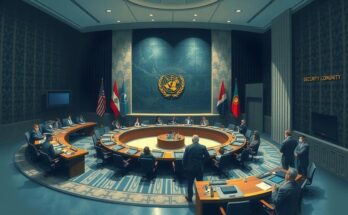Malian army clashed with Azawad separatists, resulting in 10 separatist deaths, while the separatists claim to have killed dozens of soldiers. The fighting erupted in Kidal following a military offensive, with both sides suffering losses. Videos emerged showing the aftermath of the clashes. The ongoing presence of Russian mercenaries could impact future military operations.
BAMAKO, Mali — A two-day clash between Malian security forces and an armed separatist group has resulted in significant casualties, with the Malian army reporting the deaths of ten separatists. However, the separatist group, known for its ongoing struggle for independence in the northern region, claims to have killed dozens of Malian soldiers alongside members of a Russian-backed armed force during these skirmishes.
The fighting, which escalated following a military offensive in the Kidal region, began on Thursday, according to a statement from the Malian military. By Friday, a logistics convoy belonging to the Malian forces was ambushed, although the attack was ultimately repelled, as reported by the army.
The Azawad separatists, who are keenly pursuing the establishment of an independent state, suggested in their statements that they inflicted heavier losses on the Malian troops. They claimed to have carried out the ambush on a convoy which led to the death of multiple soldiers and African Corps fighters aligned with Moscow.
Mohamed Maouloud Ramadan, the spokesman for the Azawad separatists, detailed that they seized significant provisions from the military convoy, recovering “12 trucks loaded with cereals, tankers full of diesel, one military pickup, and one armored vehicle” from a total of 30 vehicles in the convoy. They also acknowledged the death of three of their own members in the clashes.
In the wake of the conflict, viral videos circulated online purportedly showing the aftermath of the ambush, including scenes of military trucks ablaze in a vast desert landscape. While armed, hooded youths posed in front of the burning vehicles, the reported visuals also displayed uniforms resembling those of the Malian army. Media outlets such as the Associated Press have noted that they were unable to independently verify the authenticity of these videos.
According to Rida Lyammouri, a Sahel expert from the Morocco-based Policy Center for the New South, the latest events highlight the challenges faced by security forces operating in the rugged terrain of Kidal. Lyammouri states, “It’s difficult to gather actionable intelligence to protect their convoys, and this gives a significant advantage to armed and jihadist groups.”
The recent clashes have unfolded shortly after Wagner, the Russian mercenary group that had been cooperating with Malian security forces, declared its departure from the country. However, the Africa Corps, operating under direct orders from the Russian defense ministry, has confirmed its ongoing presence in Mali, maintaining approximately 2,000 mercenaries, as stated by U.S. officials.
The specific number of mercenaries associated with Wagner as opposed to those with the Africa Corps remains unclear, leaving observers on edge about the evolving military landscape in Mali.
The recent confrontations in northern Mali illustrate the ongoing complexities of the conflict between separatist groups and the Malian army, particularly with the involvement of external forces like the Russian-backed Africa Corps. As casualties mount on both sides, the ability of Malian forces to effectively operate in challenging terrains raises concerns about future stability in the region. The situation remains fluid as the presence of mercenaries continues to complicate the dynamics on the ground.
Original Source: www.newsday.com




